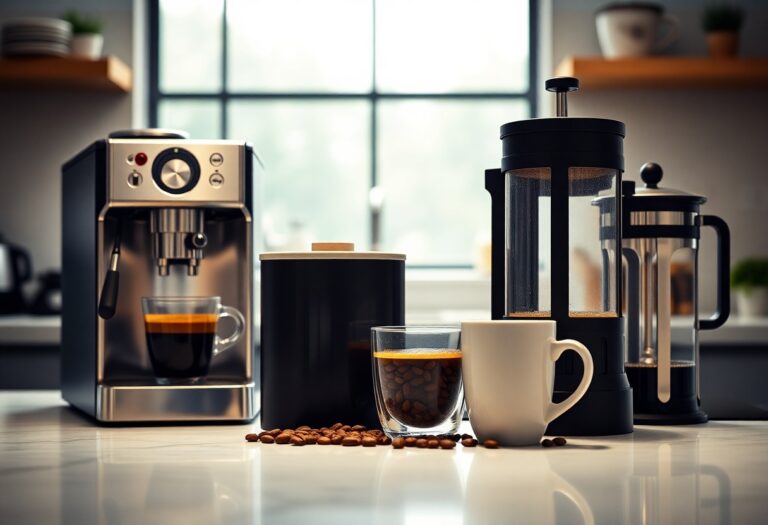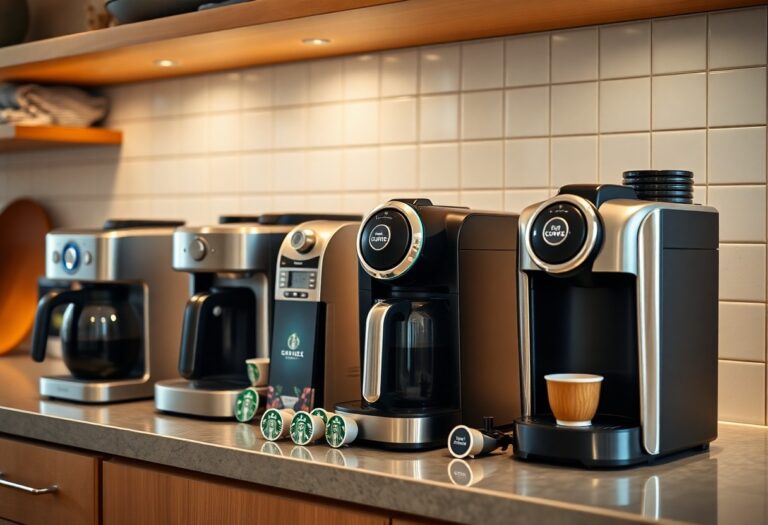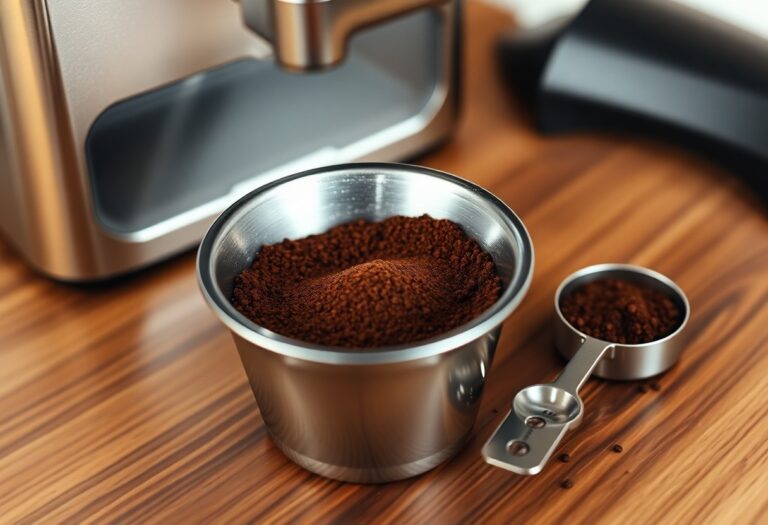What is a Bean to Cup Coffee Machine – Fresh Grinding System
Grinding your own coffee beans is the essence of a bean to cup coffee machine, offering you a fresh, flavorful brew every time. This innovative appliance combines a grinding system with brewing technology, enabling you to enjoy the maximum aroma and taste of your coffee. You can customize your beverage to your liking, ensuring that each cup is tailored to your preferences. Explore The best bean-to-cup coffee machine 2025 to enhance your coffee experience and elevate your mornings.
Key Takeaways:
- A Bean to Cup Coffee Machine allows users to grind coffee beans fresh for each cup, enhancing flavor and aroma.
- These machines typically feature an integrated grinder, which enables the seamless transition from whole beans to brewed coffee.
- Users can often customize settings such as grind size, brew strength, and cup size to suit personal preferences.
- Maintenance of a fresh grinding system is important, as regular cleaning and care will ensure the machine operates optimally and prolong its lifespan.
- Many models come with user-friendly interfaces and programmable features, making them accessible for both novice and experienced coffee enthusiasts.
The Anatomy of Bean to Cup Coffee Machines
Understanding the structure of a Bean to Cup Coffee Machine helps you appreciate the craftsmanship behind your daily brew. Each machine integrates multiple components to ensure a seamless experience, from the bean compartment to the brewing unit, carefully orchestrated to deliver a perfect cup of coffee at the push of a button.
Key Components That Make It Work
Essential components of a Bean to Cup Coffee Machine include the hopper for holding coffee beans, a grinding mechanism for transforming whole beans into grounds, a brewing unit for extracting flavor, and a water reservoir for steaming perfection. Each part plays a significant role in the overall process, ensuring the freshest and most flavorful coffee.
The Technology Behind Fresh Grinding Mechanisms
Fresh grinding mechanisms utilize advanced burr grinder technology, which allows for a consistent grind size and optimal extraction. By grinding the beans just before brewing, you achieve a more aromatic and flavorful cup. Some machines even offer adjustable grind settings, so you can customize the grind size according to the brew method.
The most effective grinding systems employ conical burr grinders, known for their ability to preserve the necessary oils and flavors of the coffee beans. These grinders create uniform coffee grounds, resulting in a balanced extraction that enhances the coffee’s complexity. A few high-end models can even adjust the grind size automatically based on the machine’s brewing temperature and pressure, ensuring consistency every time you brew. This level of sophistication empowers you to enjoy barista-quality coffee in the comfort of your home.

The Impact of Freshness on Coffee Flavor
Freshly ground coffee maximizes flavor and aroma, delivering a sensory experience that pre-ground options simply cannot match. The essence of coffee resides in the oils and compounds released upon grinding, which deteriorate rapidly over time when exposed to air. Studies have demonstrated that coffee beans can lose up to 60% of their volatile aroma compounds within a week of grinding. By ensuring you grind your beans just before brewing, you preserve these vital components, resulting in a richer and more vibrant cup of coffee.
Exploring the Flavor Profile: Freshly Ground vs. Pre-ground
The difference between freshly ground and pre-ground coffee lies in the complexity of flavor. While pre-ground coffee might provide a basic caffeine kick, it often lacks the nuanced profiles that freshly ground beans unveil. Fresh grinding allows the extraction of necessary oils, leading to a cup that boasts bright acidity and defined flavors, from berry notes to chocolate undertones. In contrast, pre-ground options often taste flat and one-dimensional.
The Role of Grind Size in Brewing Quality
Grind size significantly influences extraction quality, affecting how flavors are developed during brewing. A fine grind may lead to over-extraction, causing bitterness, while a coarse grind can result in under-extraction, yielding sour or weak flavors. Each brewing method requires a specific grind size to optimize taste – espresso demands a fine grind, while French press requires a coarser texture for proper extraction. Understanding and adjusting grind size helps you tailor your brew to your preferred flavor profile.
Utilizing the proper grind size is necessary for achieving that perfect cup. For example, a finely ground coffee in an espresso machine allows for rapid extraction under high pressure, producing a rich crema and concentrated flavor. Conversely, coarser grounds in a French press let your coffee steep longer, enhancing body and clarity. You might notice that even a slight deviation in grind size can alter the balance of flavors, highlighting the interconnectedness of grind, brewing method, and overall taste. Experimenting with grind sizes can reveal new dimensions in your coffee experience, making it worth your while to find the ideal texture for your preferred brewing style.

Choosing the Right Beans for Your Machine
Your choice of coffee beans plays a pivotal role in the flavor profile of your cup. Select high-quality, ethically sourced beans that align with your taste preferences. Experimenting with different bean origins, roast levels, and blends can unveil a spectrum of flavors, making your morning brew a delightful experience. Whether you enjoy the bold intensity of a dark roast or the vibrant acidity of a light roast, tailoring your bean selection to your palate will optimize your bean-to-cup machine’s brewing potential.
Understanding Bean Varieties and Their Characteristics
Beans primarily come from two species: Arabica and Robusta. Arabica beans, known for their sweet and complex flavors, make up about 60-70% of the world’s coffee production. In contrast, Robusta beans offer a stronger, sometimes bitter taste with a higher caffeine content. Each origin also contributes unique characteristics; for instance, Ethiopian beans may have floral notes, while Colombian beans often present a well-balanced profile. Understanding these variations allows you to choose beans that best suit your brewing style and taste preferences.
How to Store Coffee Beans for Optimal Freshness
Proper storage ensures your coffee beans maintain their freshness for longer. Store them in a cool, dark place, ideally in an airtight container to limit exposure to air, moisture, and light.
For best results, consider using a ceramic or glass container with a tight seal. Avoid placing beans in the refrigerator or freezer, as fluctuating temperatures can create condensation, affecting their flavor. Ideally, purchase beans in smaller quantities, using them within a couple of weeks of opening to fully enjoy their vibrant flavors. If you buy in bulk, keep the remaining beans sealed in a dark, dry location until you’re ready to grind and brew.
Maintenance Matters: Keeping Your Machine in Top Shape
Regular maintenance is vital to ensure your bean-to-cup coffee machine operates at peak performance and continues to deliver barista-quality brews. As you enjoy the aromatic freshness of each cup, keep in mind that thorough cleaning and occasional servicing are imperative. Refer to What Is a Bean to Cup Coffee Machine? – Something’s Brewing for more insights on maintaining this valuable kitchen asset.
Essential Cleaning Practices for Longevity
To ensure the longevity of your bean-to-cup machine, develop a routine cleaning schedule. Daily, rinse the brewing unit and the coffee grounds container to remove residue. Weekly, clean the exterior and water reservoir, while descaling at least once a month helps to eliminate mineral buildup. Utilizing the right cleaning agents, specifically designed for coffee machines, will protect every component, allowing you to savor the full spectrum of flavors for years to come.
Troubleshooting Common Issues
You may encounter occasional hiccups with your bean-to-cup coffee machine, but these can often be easily resolved. If the machine fails to grind beans or produces an unsatisfactory brew, check for jammed coffee grounds, insufficient water levels, or even misaligned components. Simple adjustments or cleaning may solve the problem, allowing you to quickly return to enjoying your favorite coffee without stress.
Some common issues, like inconsistent brewing temperature or poor espresso extraction, can often stem from a dirty brewing group or a clogged filter. If your machine produces weak coffee or the brewing times are off, inspect the grinder settings to ensure they match your preferred grind size. Regular monitoring of your machine’s performance can help you spot patterns, making troubleshooting a breeze.
The Future of Bean to Cup Technology
As the coffee industry continues to evolve, bean to cup technology is poised for significant advancements. Emerging trends hint at smarter machines equipped with app connectivity and artificial intelligence, allowing you to customize your brews from your smartphone. Expect innovations such as enhanced flavor extraction techniques and sustainability-focused designs, paving the way for a more personalized coffee experience and a smaller environmental footprint.
Innovations Enhancing the Grinding and Brewing Experience
The cutting-edge developments in bean to cup machines are enhancing both the grinding and brewing processes. Look forward to integrated grinding systems that allow precise control over grind size and consistency, coupled with advanced brewing methods that optimize temperature and pressure. These innovations not only elevate the flavor profile of your coffee but also personalize the brewing process to fit your unique preferences.
Consumer Trends Shaping the Market Landscape
The demand for high-quality coffee made at home is driving market changes, as consumers seek options that offer both convenience and barista-level results. The surge in popularity of gourmet coffee culture has led to a greater emphasis on features like customizable settings, easy cleaning processes, and machine durability. As trends shift, you may find a wider selection of machines tailored to not just brew coffee but to provide an entire coffee shop experience in the comfort of your home.
More than just convenience, today’s coffee drinkers are increasingly focused on sustainability and the origin of their beans. As consumers become more knowledgeable about coffee quality, they are prioritizing products that offer ethical sourcing and environmentally-friendly practices. Brands are responding by showcasing their commitment to sustainability through packaging, sourcing transparency, and even integrating biodegradable materials into their product designs. The fusion of premium quality and eco-conscious choices is reshaping your expectations for bean to cup machines, fueling innovation in an increasingly competitive market.
Final Words
With these considerations, you can appreciate the advantages of a bean to cup coffee machine equipped with a fresh grinding system. This innovative appliance allows you to enjoy freshly ground coffee beans for an exceptional flavor in every cup. By ensuring that each brew is made instantly after grinding, you elevate your coffee experience at home or in the office. Investing in such a machine means you’ll savor the rich aromas and tastes that only freshly ground coffee can provide, truly enhancing your daily routine.
FAQ
Q: What exactly is a Bean to Cup Coffee Machine?
A: A Bean to Cup Coffee Machine is a type of coffee maker that automatically grinds coffee beans and brews fresh coffee from them all in one compact unit. These machines are designed to provide a convenient way to enjoy freshly ground coffee at home or in an office setting, offering a streamlined process from grinding to brewing, resulting in a rich and flavorful cup of coffee.
Q: How does the fresh grinding system work in a Bean to Cup machine?
A: The fresh grinding system in a Bean to Cup machine uses built-in grinders to convert whole coffee beans into ground coffee just before brewing. When you select your coffee type or strength, the machine accurately measures and grinds the beans according to your preference. This ensures the freshest extraction, as coffee oils and flavors are preserved right up until the moment of brewing.
Q: What are the benefits of using a Bean to Cup Coffee Machine?
A: The main benefits of a Bean to Cup Coffee Machine include the convenience of having fresh coffee without needing multiple gadgets. It typically offers customization options, allowing you to control grind size, strength, and volume. Additionally, these machines often come with various brewing methods (such as espresso, cappuccino, and latte) all in one, making them versatile for different coffee preferences. Moreover, the freshness from grinding just before brewing enhances the aroma and flavor of the coffee.
Q: Are Bean to Cup Coffee Machines easy to clean and maintain?
A: Yes, Bean to Cup Coffee Machines have been designed with user-friendliness in mind, including maintenance routines. Most models feature removable brewing units and drip trays for easy cleaning. Additionally, many machines offer automatic cleaning programs for the grinder and brewing components. Regular maintenance, such as descaling water reservoirs and keeping the grinder clean, ensures optimal performance over time.
Q: Can I use pre-ground coffee in a Bean to Cup Coffee Machine?
A: While Bean to Cup Coffee Machines are primarily designed to be used with whole coffee beans for the best flavor and quality, some models may have an option to accommodate pre-ground coffee. If you choose to use ground coffee, it’s imperative to check the manufacturer’s instructions for any specific guidelines or limitations on this feature. That said, using whole beans will typically yield a superior cup of coffee due to the freshness of the grind.







